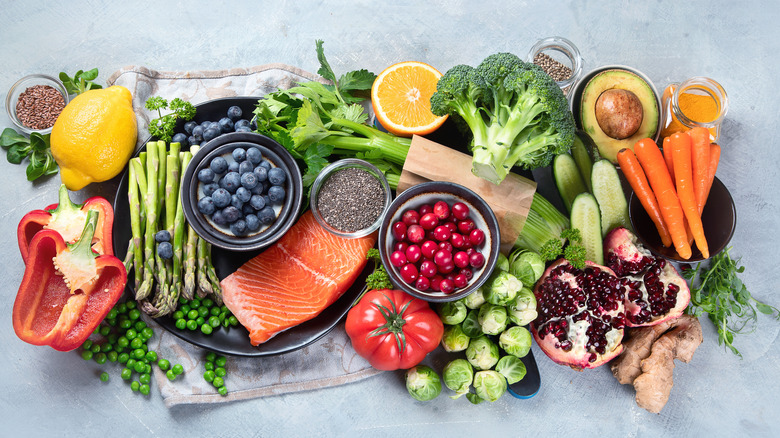The Amazing Amount Of Food The Average American Eats Each Year
If you had to guess how much the average American eats every year, what would you say? Hint: The figure is probably higher than you think.
According to 2011 data from the USDA, the average American consumes 1,996 pounds of food annually. That's about the same weight as an adult male moose, the Liberty Bell, a great white shark ... you get the idea. But that number could be even higher today, based on 2018 food consumption estimates of the major food groups over a 12-month period.
If you convert that annual amount to a daily average, you get about 5 ½ pounds of food. This number, of course, may be higher or lower for some people, depending on age, nutritional needs, and exercise level. With that in mind, here are some of the foods Americans consume the most, along with how the average American diet compares to the USDA's recommendations.
Which food groups get the most love?
After compiling data from the CDC, FDA, USDA, and other sources, economists created a pie chart that answers this question. The award for the most-consumed food group goes to dairy, with approximately 812.9 pounds consumed each year. That includes 181 pounds of milk, 31.4 pounds of cheese, and 600.5 pounds of non-cheese dairy products, such as yogurt and sour cream.
Next on the list is vegetables, weighing in at 415.4 pounds. (Unsurprisingly, most of that weight comes from potatoes, because, well, french fries.) Rounding out the top three most-consumed food groups is fruits, with an average of 273.2 pounds.
Carbs were also fairly high on the list, with 192.3 pounds coming from flour and cereal products. Wondering where the incredible, edible egg ranked? The average American eats roughly 300 of them per year, or approximately 32.7 pounds. As for other animal proteins, Americans eat an average of 110 pounds of red meat and 73.6 pounds of white meat each year.
Food consumption trends
Has the American diet changed over the years? Definitely. With all the diet fads, such as the ketogenic and paleo diets, that have gained popularity over the last few decades, it makes sense that consumption trends have changed.
In fact, the USDA recorded an increase in the consumption of meat, eggs, nuts, grains, vegetables and fruits in 2018, compared to 1970. But overall, Americans are still not eating the right amount of the right foods, based on the USDA's 2020-2025 Dietary Guidelines for Americans.
So, which foods should Americans be eating more of? The nutrient-dense foods you've been hearing about since you were a child: fruits, vegetables, and low-fat and non-fat dairy. According to the Mayo Clinic, many of these foods are high in fiber. This means that after you eat food from this group, you'll feel satisfied for longer than you would after eating a couple of high-calorie candy bars, for example. And the longer you feel full, the less likely you are to overeat and ... eat a literal ton of food every year.


